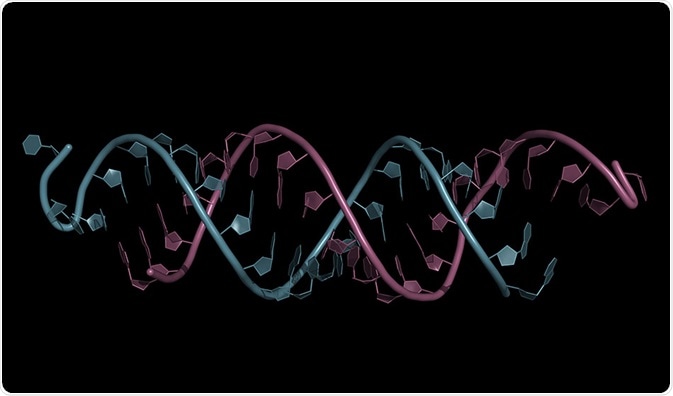By Jeyashree Sundaram, MBA
RNA interference is a cellular mechanism that hinders detrimental or unnecessary gene expression by neutralizing small interfering RNA (siRNA) and microRNA (miRNA), through interactions with messenger RNA (mRNA).

Credit: petarg/Shutterstock
This process can be used in plants, animals, and humans to block the expression of unwanted gene products, in order to prevent the development of diseases.
The determination of thousands of microRNA genes and genome sequences in various eukaryotes enhanced the detailed study of the origin and evolution of RNA interference.
The RNAi system in prokaryotes is functionally analogous and serves as a protective shield. The protein structure of RNAi in eukaryotes is restored from the archeal, bacterial and ancestral phage proteins that are engaged in DNA repair and RNA processing pathway.
Origin and evolution
Three proteins are involved in RNA interference (RNAi): RNA-dependent RNA polymerase (RdRp), Ago-Piwi, and Dicer proteins comprising RNAse III and helicase domains.
Diversity in RNAi pathways and RNAi-related complexes (i.e., RNA-induced silencing complexes (RISCs)) is generated by several paralogous forms of these key proteins that are transpired through multiple replications at various stages of eukaryotic evolution adjacent to numerous accessory proteins.
Star phylogeny is considered to be the best approximation of early eukaryotic evolution, and includes a functional RNA interference system comprising the three proteins that precede the LECA (Last eukaryotic common ancestor). LECA has the ability for siRNA-mediated gene silencing at the level of transcription and translation.
The primary function of ancestral RNAi system in plants and animals is to develop a protective shield against the transposons and viruses. This occurs at the initial stage and is later supported by LECA, possessed by RdRp.
RdRp is mainly involved in intensification of siRNA. The protective role of RNAi is sustained in eukaryotic organisms, and the specific miRNA pathways have also developed in animals, plants, and fungi.
In key proteins
Prokaryotic similarities in the three crucial proteins of eukaryotic RNAi have been determined and these proteins exhibit a particular gamut of bacterial and archael connections.
- Dicer proteins consist of a couple of enzymatic domains that include RNA helicases of Superfamily II and RNAse III. They are generally found in prokaryotes and their association in an individual protein is a eukaryotic sign and can be divided by all supergroups.
- The existence of several Ago-Piwi paralogs in metazoa denotes that animals have numerous RISCs that perform biological functions. Argonaute proteins are universally expressed and attach to miRNA or siRNA. Piwi protein expressions are constrained to a series of germ-cells, and these protein expressions combine with the RNA that interact with Piwi to enable silencing of active genetic elements and to offer a flexible shield against transposon and viruses.
- The origin of both RdRP as well as DNA-dependent RNA polymerases’ (DdRP) second largest catalytic subunit seems common. The parent eukaryotic RdRPs seems to be uncategorized viral proteins capable of removing bacteria and their operation is similar to DdRPs.
The evolution of eukaryotic RNAi mechanism obeys the principle that controls the evolution of other eukaryotic functional systems.
miRNA
The identification of miRNA families in metazoans denotes their persisting functions in every part of animal evolution.
In bilaterians, miRNA repertoire implies that the increased number of miRNA-mediated gene regulation support the formation of complexes. Hence, new miRNA contribute to the functional innovation. This is in the advanced stages of evolution.
Significant differences in the mechanism of action and biogenesis between plant and animal miRNA led to the assumption of independent origination and evolution. The secondary structures in animals and plants direct the action and mechanism of miRNA evolution.
The occurrence of RNA silencing system mediated by miRNA involved the co-evolution of three balancing or similar sequences.
Evolution of miRNA by duplication and mutation in animals
miRNA evolution takes place through duplication of existing miRNA along with new binding specificities and later by mutation that takes place in the targeted region.
In tandem replication processes, the evolution of miRNA takes place in clusters of paralogous miRNA genes in the genome. These clusters comprise multiple miRNA genes that are transcribed as an individual transcript.
The clusters are sustained during evolution process by selection for co-regulation of miRNA expression. Therefore, the clustering of miRNA genes has a greater significance in the evolutionary processes that are responsible for distribution of miRNA genes in genomes under the duplication-mutation model.
miRNA from transposable elements (TE's) inverted repeats
Many miRNA are derived from inverted repeats and transposable elements.
The hsa-mir-548 is a new family of miRNA genes present in humans. Derived from transposable elements with greater potential, it forms an miRNA with high stability and resembles a hairpin structure.
In the human genome, palindromic organization alludes an miRNA origin from TEs that generate transcripts and characteristic miRNA. The TEs are introduced into the genome sequences that influence the evolution of miRNA in animals. A recent method of TE addition into both the siRNAs and miRNAs indicates a significant way of evolution in plants.
RNA interference (RNAi): by Nature Video
Credit: nature video/Youtube
Further Reading
Last Updated: Feb 26, 2019